Penrhyndeudraeth is a small town in the ancient county of Merionethshire, situated near to the mouth of the River Dwyryd on the A487, about three miles east of Porthmadog. The community includes Minffordd and Portmeirion. The men of the area who fell during both Worlds Wars are commemorated on war memorials which are situated inside the towns Memorial Hall. This page serves to commemorate these men who are named on the Penrhyndeudraeth War Memorial. The men of Minffordd will be commemorated on a seperate web-page. I have also taken the liberty to add the details of several men from the town who do not appear to be commemorated locally.
The Great War, 1914-1918
Herbert Leslie Brock, Lieutenant, Machine Gun Corps. Herbert was born in Penrhyndeudraeth in 1890, the eldest son of William and Annie Brock. His father was from Llangwm, but in his work as a teacher had taken up a post as headmaster in Tregarth National School, after having moved his young family to Sunnyside, Tregarth. Herbert had entered Bangor University after gaining a scholarship in 1908 and studied for his BA, before taking up a teaching post at the Elmfield College in York. In February 1915 he enlisted into the 14th Battalion, Royal Welsh Fusiliers. An intelligent man, he was commissioned as a second lieutenant prior to embarking for France with the 38th (Welsh) Division on 1 December 1915, and was wounded during a very succesful trench raid during the night of 4/5 June 1916, which required him to spend some time in hospital. Upon recovering he embarked once more for France and was posted to the 29th Company, Machine Gun Corps. Herbert was killed in action somewhere in the Lys Valley, on 10 April 1918. He was 27 years old and is commemorated on the Ploegsteert Memorial, Belgium. His brother James had been killed some months earlier. Neither are commemorated at Penrhyndeudraeth, although both men are commemorated at St. Mary’s Church, Tregarth.
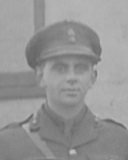
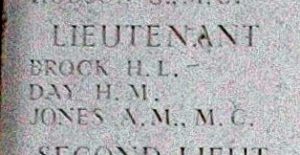
James Ifor Baxter Brock, Private, 267871, Royal Welsh Fusiliers. James was born in Tregarth in 1898, the third and youngest son of William and Annie Brock. His father was from Llangwm, but in his work as a teacher had taken up a post as headmaster in Tregarth, after having moved his young family to Sunnyside, Tregarth. James enlisted into the Royal Welsh Fusiliers alongside his brother, and was posted to France on 1 December 1915 with the 14th Battalion, Royal Welsh Fusiliers, which was attached to the 38th (Welsh) Division. He would have taken part in the divisions famous assault on Mametz Wood during July 1916 and during the following year took part in its capture of the Pilckem Ridge on 31 July 1917. On 1 September 1917 the battalion was back in the front line, near Iron Cross, when battalion HQ was hit by German artillery fire. There was no major damage, apart from woodwork at the entrance being set ablaze, but the dugout was evacuated for a while. After sometime a party of officers and men returned, but unfortunately the blaze ignited a box of grenades, bringing the dugout down. James was most probably the one man killed in the explosion, while three officers and seven men were wounded. He was 20 years old and is commemorated on the Tyne Cot Memorial, Belgium. His official date of death is 2 September 1917, but the battalion war diary mentions no casualties on that date, so either the diary is wrong or the official records are. His brother Herbert was killed some months later. Neither are commemorated at Penrhyndeudraeth, although both men are commemorated at St. Mary’s Church, Tregarth.
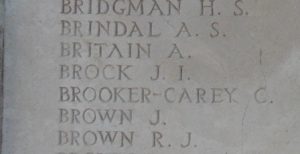
John Carroll, Private, 15383, Royal Welsh Fusiliers. John was born in Penrhyndeudraeth in 1882, the son of Thomas and Catherine Carroll. He married Rachel Evans, of Pwllheli in 1903, and the couple had five daughters over the coming years. John enlisted at Pwllheli into the 10th Battalion, Royal Welsh Fusiliers at the start of the war. The battalion moved to Salisbury Plain, joining 76 Brigade, 25th Division soon after formation, then headed to billets in Bournemouth for the winter. The division landed at Boulogne on 27 September 1915, and a month later 76 Brigade transferred to the 3rd Division, which was in the Ypres Salient. John saw his first major action during the Actions of the Bluff, and the St Eloi Craters in the Spring of 1916, where his battalion suffered heavy casualties. The Division then moved south to the Somme, and fought there at the Battle of Albert, and the Battle of Bazentin Ridge, where it captured Longueval. The Division then took part in the Battle of Delville Wood. On 20 July 1916 the 3rd Division sent in 76 Brigade, and the 10th RWF pushed into the wood to link up with the South Africans. Two Victoria Crosses were gained by the battalion during the day, but heavy casualties were suffered. John was amongst the men killed in the wood that day. The 32-year-old has no known grave and is commemorated on the Thiepval Memorial, France. He is not commemorated on the Penrhyndeudraeth War Memorial, but at Pwllheli.
Daniel Davies, Private, 17793, Oxford and Bucks Light Infantry. David was born in Whitehaven in 1894, the son of Robert and Bessie Davies. His parents were from the South Wales valleys, and by 1901 the family had moved to 2, Bryn Rhys, Penrhyndeudraeth. Daniel worked as a farm labourer prior to the war, and enlisted at St. Martin’s, Oxford into the 5th Battalion, Oxford and Bucks Light Infantry. Upon formation, the battalion joined 42 Brigade, 14th (Light) Division, moving to Aldershot and on 21 May 1915 landed at Boulogne. The Division moved to the Ypres Salient and saw its first action during the Action of Hooge, where the Division became the first to be attacked by the German use of flamethrowers. The Division then fought at the Second attack on Bellewaarde, which was a diversionary assault intended to draw German attention away from the main offensive to the south, at Loos. The 14th Division was in the Railway Wood sector during this time and launched its attack on Bellewaarde on the same day as the Loos offensive began, 25 September 1915. A large number of men of the Division was killed by their own artillery firing short in the opening barrage, and the attack was a disaster. Daniel’s battalion alone suffered the loss of 13 of their fifteen officers and 441 other ranks either killed, wounded or missing, and the survivors were relieved before moving back to Poperinghe. It was almost three weeks before the battalion had recovered enough to be able to go back into the line, moving back into the Railway Wood sector on 13 October to begin another tour of duty. Daniel had survived the carnage of the main battle, but was wounded during this second spell in the line and was evacuated to the Base Hospital at Boulogne where he died of his wounds on 31 October 1915, aged 21. He is buried in Boulogne Eastern Cemetery, France.
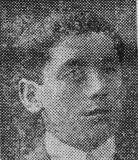
David Richard Davies, Private, 25465, Royal Welsh Fusiliers. David was the son of Evan and Catherine Davies, of Boston House, Penrhyndeudraeth. He worked as a labourer prior to enlisting at Llandudno into the 17th Battalion, Royal Welsh Fusiliers on 27 February 1915. The battalion was initially raised as part of 128 Brigade, 43rd (Welsh) Division, and trained in North Wales before moving to Salisbury Plain in the summer of 1915, where the formation became 113 Brigade, 38th (Welsh) Division. The Division embarked for Boulogne on 2 December 1915 and then took over the Nursery Sector, near Fleurbaix, for trench initiation. The Division then spent several weeks in the Cuinchy sector, where David became one of many men seconded to the Royal Engineers for trench improvement work. He returned to the 17th RWF prior to the Divisions move south to the Somme in June 1916, and took part in the assault on Mametz Wood. Following its ordeals at Mametz, the Division was moved to the Ypres sector and took over the Canal Bank defences north of Ypres. It remained here until launching its assault on the Pilckem Ridge on 31 July 1917, as part of the opening of the Passchendaele offensive. On 4 August David was allowed to go home on leave for two weeks, and by the time he returned to France the Division had moved to Armentieres. In March 1918 the Division moved back to the Somme, to relieve Divisions which had been badly hit during the German Spring offensive, and remained in the sector, north of Albert, until launching the great offensive across the Ancre Valley on 21 August 1918. David was then allowed home for a second spell of leave and was admitted to Bangor Military Hospital on 29 September 1918, suffering from Myalgia, but was discharged on 4 October, re-joining the 17th RWF in France. The Division had by now crossed the Hindenburg Line, and David went back into action during its assault on the River Selle. On 29 October 1918 the 17th RWF sent three Companies on a trench raid in Englefontaine, which proved successful, with a large number of prisoners taken and about 40 Germans killed. David was unfortunately killed during the raid that day. The 25-year-old is buried in Englefontaine British Cemetery, France.
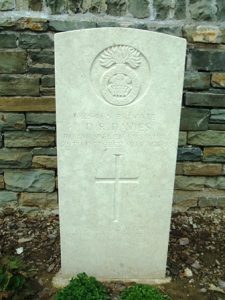
Edmund Evan Davies, Private, 36208, Duke of Cornwall’s Light Infantry. Edmund was the son of Ellis and Jane Davies, of Tyn Y Ffrwd Terrace, Penrhyndeudraeth. He worked as a collier prior to enlisting into the Cavalry, and was posted to the 5th Reserve Cavalry Regiment. After training he was posted to France to the Infantry Base Depot and from there was posted to the 1st Battalion, Duke of Cornwall’s Light Infantry, which was attached to 95 Brigade, 5th Division. He probably joined the battalion on the Somme, where it took part in the fighting at High Wood, Guillemont, Flers-Courcelette, Morval and Le Transloy. On 5 October, after suffering heavy casualties, the Division moved to Festubert, where it remained until March 1917 before moving to the Arras sector and fought at the Battle of Vimy in April 1917. On 3 May the Division fought in the Third Battle of the Scarpe, and captured Oppy Wood. On 7 September, the Division moved north to join the Passchendaele offensive, and on 26 September fought at the Battle of Polygon Wood. The Division took part in further fighting here, at Broodeseinde and Poelcapelle in September, and on 26 November fought in the Second Battle of Passchendaele. Edmund was killed at Passchendaele on 6 November 1917, aged 25. He has no known grave and is commemorated on the Tyne Cot Memorial, Belgium.
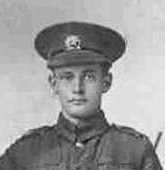
Hugh Davies, Lance Sergeant, 10689, South Wales Borderers. Hugh was the grandson of Mrs. Jannett Davies, of 11, School Street, Penrhyndeudraeth. By the age of 16 he had left home, and was lodging at 17, Glyn Street, Pontypridd, where he had gained worked as a collier. Hugh enlisted at Brecon into the South Wales Borderers soon afterwards, and by the outbreak of war was in Tientsin, China with the 2nd Battalion, South Wales Borderers. The battalion landed at Lao Shan Bay on 23 September 1914 and took part in a combined operation against the German held port of Tientsin, before embarking at Hong Kong for Plymouth on 4 December. Upon arrival, the battalion was sent to Rugby, joining 87 Brigade, 29th Division, and on 17 March 1915 sailed from Avonmouth for Alexandria. The Division then sailed for Mudros, and on 25 April 1915 landed at Morto Bay, Gallipoli, under heavy fire. The Division saw heavy fighting at Gallipoli, before being evacuated to Egypt on 11 January 1916. On 15 March the Division landed in Marseilles, and entrained for Northern France, before taking up the line opposite Y-Ravine, near Beaumont Hamel. The 2nd SWB became the victim of an embarrassing raid here soon after arriving on the Somme, and suffered heavy casualties, as well as a number of men taken prisoner by the Germans. During June 1916 the Division readied itself for the forthcoming Somme offensive, due to be launched on 1 July 1916, and over the weeks preceding the offensive, took part in several trench raids to gain intelligence in readiness. Hugh was wounded during one of these raids, probably on one carried out on 27 June, and died of his wounds on 28 June 1916, aged 21. He is buried in Engelbelmer Communal Cemetery, France.
William Davies, Private, 201432, Royal Welsh Fusiliers. William was the son of William and Mary Ann Davies, of 5, Bryniau Hendre, Penrhyndeudraeth. Prior to the war he was living at Brondarw Arms, Llanfrothen, where he worked as a farm servant. He enlisted at Dolgellau into the 4th Battalion, Royal Welsh Fusiliers. Upon completing his training, he was posted to France, initially to the 15th Battalion, Royal Welsh Fusiliers. He was then immediately posted to the 17th Battalion, Royal Welsh Fusiliers, which was attached to 115 Brigade, 38th (Welsh) Division. He most probably joined the Division as a re-enforcement following its epic assault on the Pilckem Ridge on 31 July 1917. The Division then took part in the Battle of Langemarck before moving to the Armentieres sector for the winter. On 21 March 1918 the British were hit hard during the German Spring offensive on the Somme, and the 38th Division was sent south to relieve two of divisions which had taken heavy casualties, taking up the line north of Albert, facing Thiepval Ridge, across the Ancre Valley. The Division remained here until launching its offensive across the Ancre on 21 August 1918, capturing the Thiepval Ridge before taking part in the great advance towards the Hindenburg Line. By 30 August the Division had captured the village of Lesboeufs, and on the morning of 1 September 1918 launched an attack on the German line running from Lesboeufs to Sailly-Saillisel, on a two-brigade front. William was killed during the heavy fighting that day. He was 23 years old and is buried in Guards’ Cemetery, Lesboeufs, France.
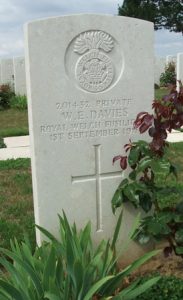
Simeon Edwards, Private, 13762, Welsh Regiment. Simeon was the son of Edward and Sarah Edwards, Britannia House, Penrhyndeudraeth. By 1911 he was working as a miner, and was living at 92 Greenfield Street, Bargoed, but by the time of the war he was living in Aberfan. Simeon enlisted at Merthyr into the 9th Battalion, Welsh Regiment, and was posted to D Company. The battalion formed at Cardiff before moving to Salisbury Plain, joining 58 Brigade, 19th (Western) Division and on 18 July 1915 Simeon landed in France with the battalion. The battalion moved to the Nursery Sector near Fleurbaix for trench initiation, and on 28 August took over the sector from Grenadier road communication trench, just north of Givenchy, to Farm Corner, near Festubert. The Division received orders here for a diversionary attack it was to carry out, while the Allies launched a major offensive just to the south, at Loos. At dawn on 25 September 1915 the Battle of Loos opened, behind a curtain of poison gas. At the same time the British launched attacks at Ypres and Givenchy. The 19th Division launched its diversionary assault simultaneously to the main offensive but the men were mown down by machine-gun fire, for no gain. Within fifteen minutes 12 officers, 4 company sergeant-majors and approximately 300 other ranks had been killed or wounded in the 9th Welsh alone. Simeon was among the dead. The 24-year-old has no known grave and is commemorated on the Loos Memorial, France. He is also commemorated on the Aberfan War Memorial.
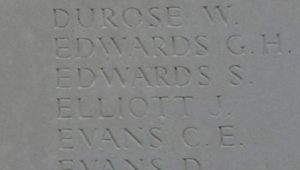
Edwards, W. This man cannot presently be identified.
Robert Thomas Evans, Private, 53779, Royal Welsh Fusiliers. Robert was the adopted son of John and Eliza Evans, of Fair View, High Street, Penrhyndeudraeth. He worked as a Porter for the Cambrian Railways at Afonwen Station prior to the war. Robert enlisted at Porthmadog into the Royal Welsh Fusiliers, and after training was posted to the 1st Battalion, Royal Welsh Fusiliers, which was attached to 22 Brigade, 7th Division. The Division was on the Somme in 1916, and on the opening day of the battle captured Mametz village. It then fought at the Battle of Bazentin Ridge, and the Attacks on High Wood, and also during the Battle of Delville Wood, and the Battle of Guillemont, before spending the winter on the Ancre. In March 1917 the Division followed up the German Retreat to the Hindenburg Line, and took part in Flanking Operations Round Bullecourt, taking part in heavy fighting alongside the Australians. Robert probably joined the battalion around this time, as one of a large number of reinforcements sent out to bolster its depleted ranks before the Division moved to Ypres. He would have taken part in the Divisions attack on Polygon Wood and in the later battles to gain control of the Passchendaele Ridge. The Division was then relieved and moved to Italy to support the Italian army. Robert was killed in action in Italy on 3 May 1918, aged 22. He is buried in Granezza British Cemetery, Italy.
William Henry Fitzpatrick, Private, 204561, Labour Corps. William was the husband of Elizabeth Fitzpatrick, of 5, Glanllyn, Penrhyndeudraeth. He served during the war with the Labour Corps, as he was probably too old for front line infantry duty. William was discharged from the army on 22 February 1919 and returned home to Penrhyndeudraeth, but died of bronchitis and emphysema on 10 March 1923, aged 51, too late for commemoration by the CWGC. William is not commemorated on the Penrhyndeudraeth War Memorial.
Richard Rowland Griffith, Lance Corporal, 21080, Royal Welsh Fusiliers. Richard was the son of John and Catherine Griffith, of Penygraig, Croesor. He had moved to 54, Wyndham Street, Porth to work as a collier prior to the war. Richard enlisted at Pontypridd into the Welsh Regiment on 3 March 1913 and was posted to the Depot at Cardiff, but was discharged at his own request a month later, returning to Porth. He then re-enlisted at Abertridwr following the outbreak of war and was posted to the 14th Battalion, Royal Welsh Fusiliers. He joined the battalion at Llandudno, where it was attached to 128 Brigade, 43rd (Welsh) Division. The Division trained in North Wales before moving to Winchester in the summer of 1915, and the formation was renumbered to 113 Brigade, 38th (Welsh) Division. Richard landed in France with the battalion on 2 December 1915, then the entire Division moved to the Nursery Sector near Fleurbaix for trench initiation. The Division then moved to the Cuinchy sector, before marching south to the Somme in June 1916, and famously captured Mametz Wood the following month, during the Somme offensive. The battered Division was then withdrawn, spending a month at Hébuterne before taking over the Canal Bank sector, north of Ypres, where it would remain for the next twelve months. On 12 December 1916 the 14th RWF moved out of the line for a program of training and didn’t move back into the line until 13 January 1917. On 31 January 1917 the battalion was in the line on the Canal Bank sector, carrying out trench improvement work, when Richard was killed, probably whilst on a wiring party. He was 24 years old, and is buried in Bard Cottage Cemetery, Belgium. (The memorial shows A. Griffith, but this is the only man named Griffith from Penrhyndeudraeth who fell).
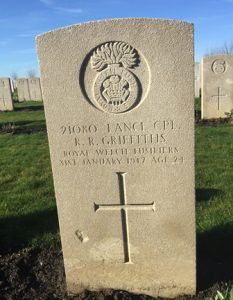
Evan Hughes, Private, 291405, Royal Welsh Fusiliers. Evan was the son of David and Ann Hughes, of Bryniau Hendre, Penrhyndeudraeth. He worked as a labourer prior to enlisting at Penrhyndeudraeth into the Royal Welsh Fusiliers on 11 December 1915, and was initially posted to the 3/7th Battalion, Royal Welsh Fusiliers. On 3 July 1916 he embarked for Egypt and joined the 1/7th Battalion, Royal Welsh Fusiliers, which was attached to 158 Brigade, 53rd (Welsh) Division. The Division had taken part in the Gallipoli campaign the previous year, before being evacuated to Egypt to join the EEF, and spent much of 1916 guarding the Suez Canal before helping drive the Turks out of the Sinai. Once the Suez Canal was secure, the EEF planned to clear the Turks out of Palestine, and as a result launched the First Battle of Gaza on 26 March 1917. The battle turned into chaos, partly as a result of a thick fog shrouding the battlefield, but also because of poor communication between the various units involved, and all of the gains made were evacuated by the end of the day. Evan had been killed during the attempt to clear Gaza that day. The 22-year-old has no known grave, and is commemorated on the Jerusalem Memorial, Israel.
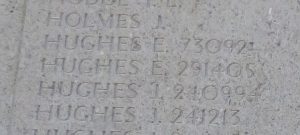
Griffith Hughes, Private, 41192, The King’s (Liverpool Regiment). Griffith was the son of Griffith and Jane Hughes, of Bethel Terrace, Penrhyndeudraeth. He enlisted at Penrhyndeudraeth into the Royal Field Artillery, but after training was transferred to the 18th Battalion, King’s (Liverpool Regiment). The battalion had been in France since 25 December 1915 attached to 21 Brigade, 30th Division, but had suffered heavy casualties during the German Spring offensive, so was reduced to a cadre on 14 May 1918. Griffith then joined the 13th Battalion, King’s (Liverpool Regiment), which was, by then, attached to 9 Brigade, 3rd Division. The Division was rebuilding, following heavy fighting following the German offensive, but by August was ready to fight again and from 21 August 1918 took part in the great offensive towards the Hindenburg Line. The 3rd Division fought at the Battle of the Canal du Nord, and pushed on towards Cambrai. Griffith was killed during this advance to Cambrai, on 3 October 1918, aged 27. He is buried in Ribecourt Railway Cemetery, France.
John Hughes, Private, 47612, Royal Inniskilling Fusiliers. John was the son of Benjamin and Margaret Hughes, of Penrhyndeudraeth. He married Jane Jones in 1903, and the couple had two children. Following Jane’s death in 1915, the children were taken in by John’s sister, Mrs Annie Davies, of Bryn Saethon. John enlisted into the Royal Welsh Fusiliers, but after completing his training was posted to the 13th (Garrison) Battalion, Royal Inniskilling Fusiliers, which joined 119 Brigade, 40th (Bantam) Division on 11 June 1918. The Division was stationed near St. Omer at the time. John took ill around this time, and died at the 58th Casualty Clearing Station, France on 11 July 1918, aged 41. He is buried in Longuenesse (St. Omer) Souvenir Cemetery, France.
Robert Hughes, Private, 19602, Royal Welsh Fusiliers. Robert was the son of John and Laura Hughes, of 17, Snowden Street, Porthmadog. His mother was from Minffordd. Robert moved to Bedlinog by 1911 to work as a collier, before becoming a grocer, but travelled home to enlist at Penrhyndeudraeth into the 13th Battalion, Royal Welsh Fusiliers soon after the outbreak of war. The battalion formed at Rhyl, then moved to Llandudno, to join 128 Brigade, 43rd (Welsh) Division. During the summer of 1915 the Division moved to Winchester where it was renumbered, and the formation became 113 Brigade, 38th (Welsh) Division. When the battalion embarked for France on 2 December 1915, Robert remained in Winchester, but was sent out among a number of other men as reinforcements the following year. He probably took part in the Divisions famous assault on Mametz Wood in July 1916, and then moved with the Division to Hébuterne, where it spent a month before being moved to the Canal Bank sector, north of Ypres. The Division held this sector for almost twelve months, during the build up to the opening assault of the Third Battle of Ypres, when it assaulted the Pilckem Ridge on 31 July 1917. Robert sadly did not survive that long. He was in a dugout on the canal bank on 21 June 1917 when a German shell crashed into it, killing Robert and another man. He was 28 years old and was buried in Bard Cottage Cemetery, Belgium. One of his brothers, Isaac, died in 1921 as a result of illness contracted during the war. Robert is also commemorated on the Porthmadog War Memorial.
Owen Humphreys, Private, 10019, King’s Shropshire Light Infantry. Owen was born at Llanfihangel, the son of David and Mary Ann Humphreys. After his father’s death in 1905, the Owen moved to Furnace Cottage, Eglwysfach to live with his Aunt, Annie Hughes. He worked as a collier at Treharris prior to enlisting into the 1st Battalion, King’s Shropshire Light Infantry, and landed with the battalion in France on 10 September 1914, where it was attached to 16 Brigade, 6th Division. Owen was wounded at some time, and after recovering was posted to the 2nd Battalion, KSLI, sending home a series of vivid letters, detailing his experiences at war. By the beginning of 1918 he had been wounded four times, and returned home on leave to recuperate. On 15 June 1918 Owen was joined by a friend from the 2nd KSLI who was also on leave, and the pair borrowed two bicycles to ride into Aberystwyth. Owen crashed his cycle on a bend at Llanbadarn, and sustained injuries which caused him to die in hospital later that day. He was 22 years old, and was buried with full military honours in Eglwysfach (St. Michael) Churchyard.
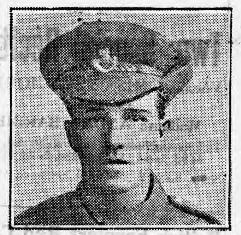
Rhys Roberts Humphreys, Air Mechanic 2nd Class, 109537, Royal Flying Corps. Rhys was born on 4 April 1897, the son of John Evans Humpreys and Elizabeth Humphreys, of Gwynfryn, Llanbedr. He was studying at Oxford when war broke out, and had served with the Officer Training Corps. He was commissioned as a Second Lieutenant into the Welsh Regiment on 30 August 1915 and served for twelve months before being discharged and re-enlisted at Armoury House into the Honourable Artillery Company on 20 October 1916. He served in France from 10 October 1916 until 22 December 1916 before returning to England to be discharged to a commission into the Royal Naval Air Service. He joined the RNAS on 8 April 1917 and was posted to Crystal Palace for training, before joining the RNAS Airship Depot at Wormwood Scrubbs, but went AWOL and was discharged from the RNAS as a result. He then joined the Royal Flying Corps, and was posted to the 35th Training Squadron to train as a pilot. On 15 March 1918, Rhys was undertaking flying instruction aboard a Bristol F.2b, Serial C4647, with Captain Edward Fraser Norris, and was carrying out loops, when the wings folded and the aircraft crashed into the ground at Port Meadow Aerodrome, Oxford, killing both men. Rhys was 21 years old and his remains were brought home for burial in Nazareth Calvinistic Methodist Cemetery, Penrhyndeudraeth. He is also commemorated on the Llanbedr War Memorial.
Edwin Richard Jones, Second Engineer, Mercantile Marine. Edwin was the son of Edwin and Catherine Jones, of Bryn Meurig, Penrhyndeudraeth. He enlisted into the Mercantile Marine some time prior to the war and trained as a Marine Engineer. By 1918 he was serving as Second Engineer aboard the Reardon Smith steamship SS Dungeness. Edin appears to have been killed when his ship was attacked by a German submarine on 30 May 1918, but the ship was not sunk. The body of the 36-year-old was brought back home by his Captain, W. Rodger Hughes, of Porthmadog, and he was buried in Holy Trinity Churchyard, Penrhyndeudraeth.
Griffith Edward Jones, Private, 2913, Royal Welsh Fusiliers. Griffith was the son of William and Elizabeth Jones, of Gwynfa, Penrhyndeudraeth. He married Maggie Williams, of 16, Glanllyn Terrace, Penrhyndeudraeth in 1913 and the couple had two sons. Griffith enlisted at Newtown into the 1/7th Battalion, Royal Welsh Fusiliers. The battalion was a Territorial unit, which mobilised for war at Newtown in August 1914, as part of North Wales Brigade, Welsh Division and moved to Conway until the end of the month, before moving to Northampton. In December the Division moved to Cambridge and then in May 1915 to Bedford, where the Division was numbered and the formation became 158 Brigade, 53rd (Welsh) Division. On 19 July 1915 the entire Division sailed from Devonport for Imbros and on 9 August 1915 landed at Suvla Bay. The infantry moved off the beaches into the bush, but due to a lack of maps and no knowledge of the terrain, many of the units became disorientated, and the situation became chaotic. Griffith was killed at Gallipoli on 10 August 1915, aged 27. He has no known grave and is commemorated on the Helles Memorial, Gallipoli. Two of his brothers, Robert Owen Jones and John Henry Jones, also fell during the war.
Hugh Jones, Second Lieutenant, Leicestershire Regiment. Hugh was born on 20 January 1887, the son of Owen and Sarah Jones, of Bryn Hyfryd, Penrhyndeudraeth. He was educated at Croesor Council School and served an apprenticeship as a Grocer at Llanrwst and Criccieth, before running his own business at Rhyl. He enlisted at Rhyl into the 16th Battalion, Royal Welsh Fusiliers on 14 October 1914 and whilst at Winchester with the battalion underwent an Officers Training course prior to being commissioned into the South Staffordshire Regiment on 20 November 1915. He was then posted to the 7th Battalion, Leicestershire Regiment. He married Elizabeth Ellen Roberts, of Henfryn, Colwyn Bay, on 12 April 1916 and on 15 July 1916 embarked for France with his new battalion, which was attached to 110 Brigade, 37th Division. The Division concentrated near St Omer by 2 August 1915 and moved to the Somme, taking part in the Attack on the Gommecourt Salient, during the first phase of the Battle of the Somme. Hugh was killed in action near Gueudecourt on 27 September 1916, aged 29 and was reported to have been buried in Gird Trench. His grave was lost in further fighting, so Hugh is commemorated on the Arras Memorial, France.
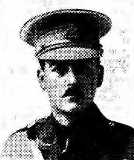
Humphrey Jones, Private, 12328, Royal Welsh Fusiliers. Humphrey was the son of Humphrey and Jane Jones, of Penrhyndeudraeth. He had moved to the South Wales valleys to find work by 1901 and in 1907 married Maria Margery Edwards. The couple set up home at 18, New Century Houses, Trealaw, where their three children were born. Humphrey enlisted at Tonypandy into the 8th Battalion, Royal Welsh Fusiliers soon after the outbreak of war. The battalion moved to Salisbury Plain to join 40 Brigade, 13th (Western) Division. On 30 June 1915 the Division sailed for Alexandria, and moved to Mudros before being landed at Cape Helles, Gallipoli from 6 July 1915, relieving the 29th Division. The Division then left and returned to Mudros at the end of the month, before landing at ANZAC Cove from 3 August 1915, to fight alongside the Anzacs during the ensuing Battles of Sari Bair, Russell’s Top, and Hill 60, ANZAC. Humphrey managed to survive all of these horrific actions, but was killed by Turkish shellfire whilst in the trenches on 22 September 1915, aged 31. He has no known grave and is commemorated on the Helles Memorial, Gallipoli. Humphrey is not commemorated at Penrhyndeudraeth.
John Henry Jones, Lance Corporal, 19141, Royal Welsh Fusiliers. John was the son of William and Elizabeth Jones, of Gwynfa, Penrhyndeudraeth. He enlisted at Penrhyndeudraeth along with his brother Robert into the 16th Battalion, Royal Welsh Fusiliers soon after the outbreak of war. The battalion formed at Llandudno, joining 128 Brigade, 43rd (Welsh) Division. During the summer of 1915 the Division moved to Winchester where it was renumbered, and the formation became 113 Brigade, 38th (Welsh) Division. John embarked for France with the battalion on 2 December 1915, and the battalion moved to the Nursery Sector near Fleurbaix, where the Division was initiated into trench warfare. On 10 December the 16th RWF moved into the trenches at Laventie, each Company being attached to a battalion from the Guards Division for training. On 17 December 1915, John was on sentry duty when he was shot by a German sniper and killed. The 20-year-old was buried in Rue-Du-Bacquerot (13th London) Graveyard, Laventie, France. According to a newspaper report at the time, John was engaged to a young woman from Porthmadog. Two of his brothers, Robert Owen Jones and Griffith Edward Jones, also fell during the war.
Lewis Jones, Private, 28359, Royal Welsh Fusiliers. Lewis was the son of Lewis and Mary Jones, of 6, Osmond Terrace, Penrhyndeudraeth. He worked as a quarryman prior to enlisting at Penrhyndeudraeth into the 19th Battalion, Royal Welsh Fusiliers on 22 February 1915. The battalion had been raised in March 1915 by the Welsh National Executive Committee as a bantam Battalion attached to the 38th (Welsh) Division, but in September 1915 was moved to Aldershot to join 119 Brigade, 40th (Bantam) Division. The Division moved to France during the first week of June 1916, and moved to the front near Loos. Late in 1916 it moved south to the Somme, and fought at the Battle of the Ancre, remaining in the area over the winter. In March 1917 the Germans withdrew to their shortened line, called the Hindenburg Line, and the 40th Division was one of the Divisions that followed the withdrawal. Lewis was shot in the spine on 21 April while the Division was moving towards the Hindenburg Line. He was evacuated to the base hospital at Le Havre before being brought back to the 4th London General Hospital, where he sadly died of his wounds on 6 June 1917, aged 20. His remains were brought home and he was buried in Holy Trinity Churchyard, Penrhyndeudraeth.
Morris Owen Jones, Quartermaster, Mercantile Marine. Morris was the son of Captain Edward and Mrs Ann Jones, of Mount Pleasant, Penrhyndeudraeth. He served with the Mercantile Marine as Quartermaster aboard the SS Pyrrhua. Morris died at the General Hospital, Shanghai, China on 15 December 1917, aged 45. He is not commemorated by the CWGC, so nothing further is currently known of him. His brother, Owen Gwilym Jones, had been killed at Gaza earlier that year. Just before his mother received news of Morris’ death, she had also had a telegram informing her that a third son, Lieutenant Edward Jones, was in Manchester Hospital, after being severely wounded.
Owen Gwilym Jones, Second Lieutenant, Royal Welsh Fusiliers. Owen was born on 30 April 1886, the son of Captain Edward and Mrs Ann Jones of Mount Pleasant, Penrhyndeudraeth. He was educated at Bangor University, gaining his BA before becoming assistant schoolmaster at Ystalyfera, and then at Tredegar County School prior to the war. He was commissioned into the 3/7th Battalion, Royal Welsh Fusiliers on 21 August 1915 and was posted to Egypt, joining the 1/7th Royal Welsh Fusiliers. The battalion was a Territorial unit, which mobilised for war at Newtown in August 1914, as part of North Wales Brigade, Welsh Division and moved to Conway until the end of the month, before moving to Northampton. In December the Division moved to Cambridge and then in May 1915 to Bedford, where the Division was numbered and the formation became 158 Brigade, 53rd (Welsh) Division. On 19 July 1915 the entire Division sailed from Devonport for Imbros and on 9 August 1915 landed at Suvla Bay. Owen arrived in Egypt on 26 January 1916, joining the Division after it had been evacuated to Egypt following the closure of the Gallipoli campaign. The Division then joined the EEF, helping drive the Turks out of the Sinai and securing the Suez Canal zone before the campaign to drive the Turks out of Palestine was launched. The EEF launched its first assault on the strategically important city of Gaza on 26 March 1917, but a dense cloud settled over the battlefield, and the situation turned into chaos, with poor communication between the assaulting divisions resulting in a complete failure to hold onto the ground gained. Owen was killed at some time during the days fighting. The 30-year-old has no known grave and is commemorated on the Jerusalem Memorial, Israel. He is also commemorated on war memorials at Bangor University, and at Tredegar. His eldest brother, Morris Owen Jones, died later that year.
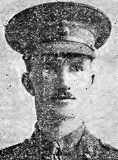
Robert Owen Jones, Private, 19146, Royal Welsh Fusiliers. Robert was the son of William and Elizabeth Jones, of Gwynfa, Penrhyndeudraeth. He enlisted at Penrhyndeudraeth along with his brother John into the 16th Battalion, Royal Welsh Fusiliers soon after the outbreak of war. The battalion formed at Llandudno, joining 128 Brigade, 43rd (Welsh) Division. During the summer of 1915 the Division moved to Winchester where it was renumbered, and the formation became 113 Brigade, 38th (Welsh) Division. John embarked for France with the battalion on 2 December 1915, and the battalion moved to the Nursery Sector near Fleurbaix, where the Division was initiated into trench warfare. On 10 December the 16th RWF moved into the trenches at Laventie, each Company being attached to a battalion from the Guards Division for training. His brother John was killed here soon afterwards, but Robert remained with the battalion. Robert was killed in action at a position known as the Moated Grange, on 9 June 1916, aged 19. He is buried in Rue-Du-Bacquerot No. 1 Military Cemetery, Laventie, France. Two of his brothers, John Henry Jones and Griffith Edward Jones, also fell during the war.
Robert Richard Jones, Private, 55359, Royal Welsh Fusiliers. Robert was born in Ffestiniog in about 1887. He married Anne Davies in 1908 and the couple set up home at Rock Terrace, Penrhyndeudraeth prior to the war. He enlisted in the town into the Royal Welsh Fusiliers, and after training was posted to France, joining the 14th Battalion, Royal Welsh Fusiliers, which was attached to 113 Brigade, 38th (Welsh) Division. He would have probably joined the battalion after the Division was evacuated from the Somme sector, following its epic assault on Mametz Wood, and was transferred north, taking over the Canal Bank sector of the line, north of Ypres. Over the coming months the Division worked hard and gained a reputation for the good work it carried out in improving and consolidating their new trenches. From 21 February 1917 the 14th Battalion, RWF relieved the 13th RWF in the front line to begin a tour of duty, and immediately began work on improvements and wiring in No Man’s Land. No mention is made in the battalion war diary of any casualties during this period, but Robert was reported as missing on 21 February 1917, but was later found to have been killed in action on 19 February 1917, aged 29. It’s an odd date, as his battalion was in reserve on that day. He was most likely taken prisoner by the Germans, as he was originally buried in Pilckem Road German Cemetery, but after the war his grave was exhumed and moved into Poelcapelle British Cemetery, Belgium.
Tecwyn Jones, Private, 202697, East Surrey Regiment. Tecwyn was the son of David and Margaret Jones, of Llys Tecwyn, Penrhyndeudraeth. He worked as a dock porter at Liverpool prior to the war and enlisted in the city into the Cheshire Regiment on 10 December 1915. After two years on home service, on 19 December 1917 he embarked for France, joining the Infantry Base Depot at Étaples, and was posted to the 8th Battalion, East Surrey Regiment. The battalion was attached to 55 Brigade, 18th (Eastern) Division, and by early 1918 was stationed south of the Somme, and became one of the Divisions hit there by the German Spring Offensive, which was launched on 21 March 1918. The Division saw heavy fighting during the Battle of St Quentin, and suffered terrible casualties during a fighting withdrawal westward towards Villers-Bretonneux. Tecwyn was wounded during this heavy fighting on 4 April and was evacuated by the 43rd Field Ambulance to the 5th Casualty Clearing Station, where he died of his wounds on 7 April 1918, aged 26. He is buried in Picquigny British Cemetery, France.
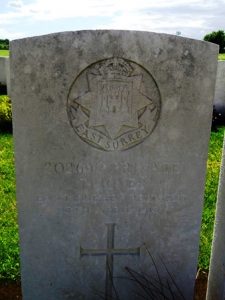
William Jones, Corporal, 334, Royal Welsh Fusiliers. William was the son of William and Catherine Jones, of Llandecwyn. He married Elizabeth Morris in 1908 and the family moved to Penybryn, Penrhyndeudraeth, with their four children. William enlisted at Criccieth into the 1/6th Battalion, Royal Welsh Fusiliers. The battalion was a Territorial unit, which mobilised for war at Carnarvon in August 1914, as part of North Wales Brigade, Welsh Division and moved to Conway until the end of the month, before moving to Northampton. In December the Division moved to Cambridge and then in May 1915 to Bedford, where the Division was numbered and the formation became 158 Brigade, 53rd (Welsh) Division. On 19 July 1915 the entire Division sailed from Devonport for Imbros and on 9 August 1915 landed at Suvla Bay. The infantry moved off the beaches into the bush, but due to a lack of maps and no knowledge of the terrain, many of the units became disorientated, and the situation became chaotic. William survived this initial chaos, but became wounded later in the campaign, and died of his wounds in hospital at Alexandria on 20 December 1915, aged 31. He is buried in Alexandria (Chatby) Military & War Memorial Cemetery, Egypt. (The memorial shows W E Jones, but there does not appear to be a man of that name from Penrhyndeudraeth.)
William John Jones, Private, 19228, Royal Welsh Fusiliers. William was the son of Ellen Jones, of Berthengron, Penryndeudraeth. By 1911 he was living at 126, Birch Grove, Porth, Rhondda, where he worked as a collier. William enlisted at Tonypandy into the 16th Battalion, Royal Welsh Fusiliers. The battalion was raised at Llandudno by the Welsh National Executive Committee from a cadre from the 13th Battalion, joining 128 Brigade, 43rd (Welsh) Division and trained in North Wales before moving to Winchester in the summer of 1915, where the formation became renumbered 113 Brigade, 38th (Welsh) Division. The Division moved to France on 2 December 1915 and moved to the Nursery Sector near Fleurbaix for trench initiation alongside the Guards Division. The Division then held a sector of the line near Cuinchy before marching south to the Somme sector in June 1916 to take part in the assault on Mametz Wood. The Division attacked on a one brigade front on 7 July, sending in 115 Brigade, but the artillery support was inadequate and the brigade suffered terrible casualties and the assault was called off. The Divisional commander, Sir Ivor Philipps, was sent home and the Division attacked again on 10 July under the temporary command of General Watts. William was killed in action on the second day of this attack, on 11 July 1916, aged 34. He has no known grave and is commemorated on the Thiepval Memorial, France.
William Samuel Jones, Sergeant, 290517, Royal Welsh Fusiliers. William was the brother of John Jones, of Talsarnau. He lived at Waen Gwella, Penrhyndeudraeth prior to the war. William enlisted into the 1/7th Battalion, Royal Welsh Fusiliers prior to the war. The battalion was a Territorial unit, which mobilised for war at Newtown in August 1914, as part of North Wales Brigade, Welsh Division and moved to Conway until the end of the month, before moving to Northampton. In December the Division moved to Cambridge and then in May 1915 to Bedford, where the Division was numbered and the formation became 158 Brigade, 53rd (Welsh) Division. William served with the battalion throughout the war, but probably missed its efforts at Gallipoli, joining the battalion in Egypt in 1916. He then took part in the Palestinian campaign, which was launched during the First Battle of Gaza in March 1917, and then in the subsequent Second and Third Battles of Gaza, which led to the capture of the cities of Jerusalem and Jericho. Towards the end of the campaign, William suffered a gunshot wound to his chest, which penetrated his right lung. He was invalided home, but died as a result of his wounds at Waen Gwella on 2 January 1919, aged 30. He was buried in Holy Trinity Churchyard, Penrhyndeudraeth by the Reverend J. Hughes on the following Saturday.
William Kellow, Second Lieutenant, Royal Air Force. William was born on 19 November 1892, the son of Alderman Moses Kellow and Nell Kellow, of Bryn Croesor, Penryndeudraeth. He was educated at Porthmadog County School and then at Dulwich, prior to going to Cambridge University, gaining his BA in 1911. He then took up a position at Gonville & Caius, Cambridge, where he was on the Mechanical Science Honours course and after graduating, he went out to South Africa, taking up a position at the Ginsburg Gold Mine, near Johannesburg. He enlisted into the Royal Flying Corps, and after training as a pilot was commissioned in October 1917. He went over to France early in 1918, just before the Royal Flying Corps merged with the Royal Naval Air Service to form the Royal Air Force, and joined 22 Squadron, which was equipped with the Bristol F.2 Fighter. On 16 September 1918 William was flying Bristol E2519 over German lines, when he was attacked by a superior force of German aircraft. After a brief fight, his aircraft was shot down and crashed between Cambrai and Douai, killing William and his Observer, Second Lieutenant Felton. The two men were initially posted as missing, but on the following day were found by the Germans who buried them at Aubigny-au-Bac Churchyard. After the war both graves were exhumed and re-buried in Naves Communal Cemetery Extension, France. William is not commemorated on the Penrhyndeudraeth memorial, but at Llanfrothen.
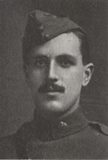
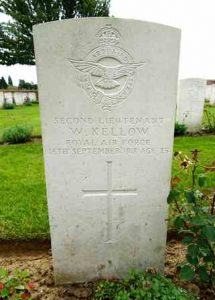
Griffith Ivor Lloyd, Private, 290626, Royal Welsh Fusiliers. Griffith was the son of Robert and Elizabeth Lloyd, of Penlan Isaf, Penrhyndeudraeth. He worked as a Butcher at Harlech prior to the war. Griffith enlisted at Harlech into the 1/7th Battalion, Royal Welsh Fusiliers as Griffith Evan Lloyd, on 9 September 1914. The battalion was a Territorial unit, which mobilised for war at Newtown in August 1914, as part of North Wales Brigade, Welsh Division and moved to Conway until the end of the month, before moving to Northampton. In December the Division moved to Cambridge and then in May 1915 to Bedford, where the Division was numbered and the formation became 158 Brigade, 53rd (Welsh) Division. On 19 July 1915 the entire Division sailed from Devonport for Imbros and on 9 August 1915 landed at Suvla Bay. The infantry moved off the beaches into the bush, but due to a lack of maps and no knowledge of the terrain, many of the units became disorientated, and the situation became chaotic. The Division was evacuated from Gallipoli to Egypt in December 1915, joining the EEF, and guarded the Suez Canal throughout 1916, before helping drive the Turks out of the Sinai. On 26 March 1917 the Division took part in an attack against the Turkish positions around the city of Gaza, but a heavy fog clouded the battlefield, hampering communications, and the attack failed. Griffith was killed during the days fighting. The 20-year-old is buried in Gaza War Cemetery.
William Lloyd, Private, 15692, South Wales Borderers. William was born in Penrhyndeudraeth in 1882. He moved to the Rhondda to work as a Collier prior to 1900, and lived with his wife Martha Lloyd and their three daughters, at 12, Balaclava Road, Penygraig. William served during the war with the 7th Battalion, South Wales Borderers. The battalion was formed at Brecon in September 1914, moving to Seaford to join 67 Brigade, 22nd Division. On 6 September 1915 the battalion landed at Boulogne, but the following month embarked at Marseilles with the Division for service in Salonika. William served the campaign in Salonika, but the climate had damaged his health and on 31 August 1917 he was discharged from the army as medically unfit. He returned home to his family at Penygraig, where he died on 10 April 1921, aged 39. William is not commemorated by the Commonwealth War Graves Commission, nor is he named on the Penrhyndeudraeth War Memorial, even though his pension cards state that his death was as a result of his service.
Evan Morris, Private, 21285, South Wales Borderers. Evan was the son of Evan and Catherine Morris, of New Shop, Penrhyndeudraeth. He worked in South Wales prior to the war and enlisted at Newport, Monmouth into the 10th Battalion, South Wales Borderers. The battalion was raised at Brecon by the Welsh National Executive Committee in October 1914, moving to Colwyn Bay in 130 Brigade, 43rd (Welsh) Division. Moving to Winchester the following year, the formation became 115 Brigade, 38th (Welsh) Division. Evan landed with the battalion at Le Havre on 4 December 1915. The Division moved to the Nursery Sector, near Fleurbaix, for trench initiation alongside the Guards Division, and later held a section of the line near Cuinchy. Evan was wounded while his battalion was holding a section of the line near Festubert. He was evacuated to the Base Hospital at Calais, where he died of his wounds on 20 March 1916, aged 23. Evan is buried in Calais Southern Cemetery, France.
Osmond Trahairn Deudraith Osmond-Williams, DSO, Captain, Welsh Guards. Osmond was born on 26 February 1883, the son of Sir Osmond and Lady Williams, of Castell Deudraeth, Penrhyndeudraeth. He was commissioned into the 15th Hussars and served in the Boer War with the 19th Hussars, retiring from the army in 1907 after being injured in a polo accident. He married Lady Gladys Margaret Finch Hatton, of Plas, Harlech on 5 February 1912, and the couple had two children. Following the outbreak of war, he was refused a commission because of his accident, so enlisted as a Private into the Royal Scots Greys (2nd Royal Dragoons), and landed in France with the regiment on 19 September 1914. The regiment was ordered to dye its famous grey horses brown soon after arriving in France, before moving to Mons with the BEF. Osmond took part in the regiments actions during the Battle of Mons, and the subsequent retreat to the Marne, before the BEF stopped the Germans at the Battle of the Aisne. He then moved to Ypres with the regiment, and saw action during the First Battle of Ypres. At the behest of Field Marshall Sir John French, Osmond was commissioned Second Lieutenant in the field as a result of his gallantry, and soon afterwards gained the award of the Distinguished Service Order at Ypres. The citation read: ‘For general gallant service near Messines in ascertaining under fire the progress of night operations, and especially on night of 31st October for leading 12th Lancers to position for counter attack in which he took part, accounting for eleven of the enemy himself.’ Following the formation of the Welsh Guards on 26 February 1915, Osmond transferred to the new regiment, and was given command of Prince of Wales Company. He landed back in France with the 1st Battalion, Welsh Guards on 18 August 1915, and the battalion joined 3rd Guards Brigade, Guards Division. The Battle of Loos opened on 25 September 1915 and the Welsh Guards had a fierce baptism of fire, when the Guards Division was thrown into action on the following day. The 3rd Guards Brigade was ordered to attack Hill 70, with the Welsh Guards in support in Loos, so the Welsh Guards moved into the remains of the village at 14.30, with Osmond leading Prince of Wales Company at the head of the battalion. At 18.20 the Welsh Guards attacked, but within 20 minutes darkness fell, and the situation soon became desperate as the men reached the summit of Hill 70 and came under heavy artillery and machine-gun fire. Osmond was seriously wounded on the hill, and died on the following day, 27 September 1915, aged 32. Two of his officers had been killed and the other two wounded. Osmond’s body was carried away from the battlefield by Private Grant, of his company, and he was buried in Lapugnoy Military Cemetery, France.
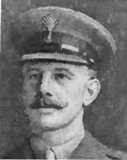
Arthur Owen, 3rd Engineer, Mercantile Marine. Arthur was born on 11 September 1882, the son of William and Jane Owen, of Church Street, Penrhyndeudraeth. He married Miss Sydney Roberts, of Holyhead, in 1910. Arthur served with the Mercantile Marine, and was 3rd Engineer aboard the steamship SS Zealand. On 6 November 1914 Arthur was taken prisoner by the Germans when his ship was impounded at Hamburg, and he was sent to Barrack 8 at Ruhleben POW Camp, near Berlin. He contracted tuberculosis due to the poor conditions in the camp and died as a prisoner of war at Dr. Weilers Sanatorium on 17 July 1916, aged 34. Little else is presently known of him, but he was probably buried in Ruhleben. He is not presently commemorated by the Commonwealth War Graves Commission.
Daniel Owen, Pioneer, 130586, Royal Engineers. David was the son of John and Ann Owen, of Llys Brothen, Penrhyndeudraeth. He enlisted into the 3/7th Battalion, Royal Welsh Fusiliers on 6 December 1915 and was posted to Park Hall Camp, Oswestry. On 25 March 1916 he was transferred to the regular army and posted to the Royal Engineers. On 19 May 1916 Daniel was posted to the 4th Battalion, Special Brigade, which was a unit specialising in the discharge of poison gas from cylinders, and was still in the Loos sector. The battalion must have suffered a catastrophe soon afterwards, as a large number of its personnel were killed and wounded during an incident on 27 June 1916. Daniel died of gas poisoning at the 4th London Field Ambulance, France on 28 June 1916, aged 19, so must have been wounded on the previous day. He is buried in Fosse No. 10 Communal Cemetery Extension, Sains-en-Gohelle, France. His brother Evan was killed the following year.
Evan Owen, Stoker 2nd Class, K/43043, Royal Navy. Evan was born on 2 November 1897, the son of John and Ann Owen, of Llys Brothen, Penrhyndeudraeth. He enlisted into the Royal Navy on 6 June 1917, and was posted to HMS Vivid II at Devonport for training. He was posted to the battleship HMS Implacable, at Portsmouth, on 11 August 1917, for further training. Once he had completed his training, he was posted aboard the destroyer HMS Brisk. On 2 October 1917 HMS Brisk was part of the escort group to Convoy HH24, steaming south-west of County Antrim. A German U-Boat, U-79 attacked the Convoy, hitting the cruiser HMS Drake, so the Convoy dispersed and Brisk was deployed to follow some of the dispersed Merchant ships. Steaming through Rathlin Sound a massive explosion blew the bow off Brisk, killing 31 sailors. Whether she had been torpedoed or struck a mine is unclear, but the stern of Brisk remained afloat and was towed into Londonderry. Evan was among the 31 men killed during the explosion. The 20-year-old has no known grave and is commemorated on the Plymouth Naval Memorial, Devon. His brother, Daniel, had been killed the previous year.
Evan Richard Owen, Private, 33294, Welsh Regiment. Evan was the son of John and Elizabeth Owen, of Tai Newyddion, Brynkir, Dolbenmaen. He married Catherine Ellen Jones, of Tanbanc, Penrhyndeudraeth, in 1911, but she sadly died whilst giving birth to their daughter Elizabeth on 14 August 1911. Evan then moved to the South Wales valleys to work as a Collier prior to the war and enlisted at Mountain Ash into the 10th Battalion, Welsh Regiment under the assumed name of Richard Owen Evans. The battalion had been formed in the Rhondda, and moved to Codford St. Mary to join 76 Brigade, 25th Division, but on 30 September 1914 went to Rhyl to join the other locally raised units in 129 Brigade, 43rd (Welsh) Division. During the following summer the Division moved to Winchester, where it became renumbered, and the formation became 114 Brigade, 38th (Welsh) Division. On 2 December 1915 Evan landed in France with the 10th Welsh, and the battalion moved to the Nursery Sector at Fleurbaix with the remainder of the Division for trench initiation alongside the Guards Division. The Division moved to the Cuinchy sector the following year, and in June 1916 marched south to the Somme, to take part in the attack on Mametz Wood. The initial assault on the wood on 7 July was a failure and the Divisional commander was sacked. The Division then attacked again on 10 July and by the time it was evacuated on 12 July the wood had been cleared. Evan survived the terrible ordeal of Mametz Wood, and moved with the Division to positions at Hébuterne, to the north. On 24 July 1916 the 10th Welsh was in the front line there, when Evan was killed in action. He was 28 years old and is buried in Hébuterne Military Cemetery, France.
John Owen Owens, Private, 22477, Welsh Regiment. John was the son of Rees and Sarah Owens, of Penrhyndeudraeth. He married the widowed Martha Isabella Symes at Weymouth on 8 April 1902, and by 1911 the family was living at 10, Pontrhondda Road, Llwynypia, Rhondda. John enlisted at Cardiff into the 5th Battalion, Welsh Regiment soon after the outbreak of war. The battalion was a Territorial unit based at Pontypridd, attached to the South Wales Brigade. In September 1914 it moved from Pembroke Dock to Tunbridge Wells and in February 1915 to Scotland on the Forth and Tay Defences. In April 1915 the South Wales Brigade moved to Bedford, becoming 159 Brigade, 53rd (Welsh) Division. On 19 July 1915 the Division embarked at Devonport for Mudros, but John did not go, probably due to his age and remained at Bedford with the 2/5th Welsh. His health then started to fail him and he was hospitalised at Cardiff, where he died of pneumonia on 17 December 1915, aged 58. John was buried in Cardiff (Cathays) Cemetery. He is not commemorated on the Penrhyndeudraeth War Memorial. (His name is at the base of the headstone).
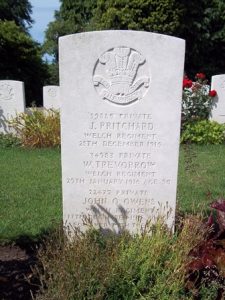
Owen, R. This man cannot presently be identified.
Samuel Owen, Sapper, 155488, Royal Engineers. Samuel was the son of John and Anne Owen, of Penybwlch, Penrhyndeudraeth. He married the widowed Jane Hughes in 1906 and by 1914 he was living with her at 22, Susannah Place, Treharris, where he worked as a Haulier. Samuel enlisted into the 20th Battalion, Welsh Regiment at Treharris on 29 June 1915, and was posted to Rhyl, where the reserve battalions for the Welsh Division were training. On 13 March 1916 Samuel was transferred to the Royal Engineers, and was posted to France, initially joining the Special Brigade, Royal Engineers, which were the gas warfare specialists. He was then transferred to the 250th Tunnelling Company, Royal Engineers. The Company was stationed in the Ypres Salient, and worked on some of the underground mines beneath Messines Ridge. These mines, some 26 in all, although some failed to detonate, were blown at 20 second intervals starting from 3.10 am on 7 June 1917, followed by an infantry assault. The explosions could be heard in London and are still today regarded as the largest non-nuclear explosions in history. Samuel was shot in the stomach by a sniper during the days after the explosion and was evacuated to No 2 Casualty Clearing Station at Bailleul where he died of his wounds on 23 June 1917, aged 31. He is buried in Bailleul Communal Cemetery Extension, France,
Richard Lewis Phillips, Engineer Sub Lieutenant, Royal Naval Reserve. Richard was born at Penrhyndeudraeth on 30 September 1877, the son of William and Mary Phillips. He worked for the London and North Western Railway at Holyhead as a Marine Engineer and married Annie Pritchard, of Holyhead, in 1904. The couple lived at Forcer View, Holborn Road, Holyhead. Richard volunteered to serve in the Royal Naval Reserve at the outbreak of war and was posted aboard the requisitioned steamship HMS Tara. She was originally named the SS Hibernia, but following her requisition by the Royal Navy was named HMS Tara, and retained most of her pre-war crew, including her Master, Captain Edward Butler Tanner. She had worked on the Holyhead to Ireland service before becoming an armed boarding steamer in 1914, and served in the North Sea before being transferred to the Mediterranean. On 5 November 1915 Tara was on patrol in the Mediterranean when she was torpedoed and sunk by the German submarine U-35. Richard was among twelve men lost in her sinking that day. The 38-year-old has no known grave and is commemorated on the Portsmouth Naval Memorial, Hampshire.
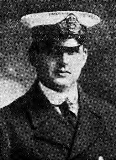
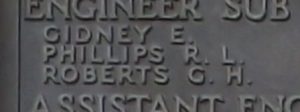
John Thomas Roberts, Ordinary Seaman, Mercantile Marine. John was the son of William and Catherine Ellen Roberts, of 11, Pool Street, Penrhyndeudraeth. He went to sea as a young man, as part of the crew of the Porthmadog based three-master schooner Ellen James, which sailed under Master Richard Cadwallader Jones, of Criccieth. On 3 April 1917 Ellen James was sailing west of Ushant, returening from Huelva to Penrhyn, carrying a cargo of copper pyrites, when she was stopped by the German submarine UC-71. The submarine then proceeded to fire her deck gun at the helpless schooner, sinking her with the loss of five of her crew of six, including two men from Penrhyndeudraeth, John and David Morris Williams. John was just 16 years old when he was killed in the sinking of Ellen James, and is commemorated on the Tower Hill Memorial, London. He is not commemorated on the Penrhyndeudraeth memorial, but at Porthmadog.
William Roberts, Private, 46267, Welsh Regiment. William was the son of David and Ellen Roberts, of Efail Wen, Penrhyndeudraeth. At some time after 1911 he moved to South Wales, and enlisted at Caerphilly into the 17th Battalion, Welsh Regiment following the outbreak of war. The 17th Welsh was raised in December 1914 as a Bantam Battalion and went to Rhyl attached to the 43rd (Welsh) Division, but in July 1915 moved to Prees Heath to join 119 Brigade, 40th (Bantam) Division. The Division landed in France on 3 June 1916, and moved to the front near Loos. Late in 1916 the Division moved south to the Somme, and fought at the Battle of the Ancre, remaining in the area over the winter. In March 1917 the Germans withdrew to their shortened line, called the Hindenburg Line, and the 40th Division was one of the Divisions that followed the withdrawal. Later in the year it took part in the Battle of Cambrai, playing an important role in the attack on Bourlon Wood. The wood lies to the north of the Arras to Cambrai road, some three miles west of the strategically important city of Cambrai. The 40th Division relieved the 62nd Division on 23 November and, supported by almost 100 tanks and 430 guns, the Division attacked Bourlon Wood on the morning of 23 November. The Division almost reached the crest of Bourlon Ridge, but became bogged down, and fierce fighting continued over the coming days. William was killed in action in the wood on 25 November 1917, aged 20. He has no known grave and is commemorated on the Cambrai Memorial, Louverval, France. (There is only one W. Roberts on the Penrhyndeudraeth memorial, but two men of that name from the town fell in WW1).
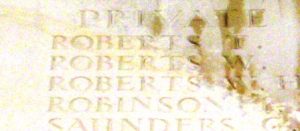
William Roberts, Driver, T4/109152, Army Service Corps. William was the son of Griffith and Margaret Roberts, of Meriondy, Penrhyndeudraeth. He lived in 69, Primrose Street, Tonypandy prior to the war, where he worked as a Haulier. William enlisted at Tonypandy into the Army Service Corps on 26 May 1915 and after training was posted to Salonika with the 579th Horse Transport Company, Army Service Corps on 1 February 1916. The Salonika campaign had opened when Bulgarian and Austrian troops invaded Greece, and the Allies sent forces out there to aid their Greek Allies. The campaign was an arduous one, with as many men being invalided through sickness as wounds. William served throughout most of the campaign, but took ill and died of broncho-pneumonia at the 6th General Hospital on 19 October 1918, aged 40. He is buried in Mikra British Cemetery, Kalamaria, Greece. (There is only one W. Roberts on the Penrhyndeudraeth memorial, but two men of that name from the town fell in WW1).
William David Roberts, Driver, 1855266, Royal Engineers. William was the son of John and Janet Roberts, of 2, Brynhyfryd, Penrhyndeudraeth. Very little is known of his service, but he served with the Royal Engineers on the Western Front during the war. He was discharged from the army after the Armistice and died of disease at home on 16 May 1922, aged 27. William is not commemorated by the Commonwealth War Graves Commission and is not named on the Penrhyndeudraeth memorial.
David Robert Rowlands, Private, 290558, Royal Welsh Fusiliers. David was the son of Owen and Jane Rowlands, of Tanyboyd, Penrhyndeudraeth. He enlisted into the 1/7th Battalion, Royal Welsh Fusiliers on 12 August 1914. The battalion was a Territorial unit, which mobilised for war at Newtown in August 1914, as part of North Wales Brigade, Welsh Division and moved to Conway until the end of the month, before moving to Northampton. In December the Division moved to Cambridge and then in May 1915 to Bedford, where the Division was numbered and the formation became 158 Brigade, 53rd (Welsh) Division. On 19 July 1915 the entire Division sailed from Devonport for Imbros and on 9 August 1915 landed at Suvla Bay. The Division remained at Gallipoli until being evacuated to Egypt in December 1915, where it joined the EEF, and helped guard the Suez Canal before taking part in operations to drive the Turks out of the Sinai. On 26 March 1917 the Division took part in the First Battle of Gaza, an attempt to capture the strategic city of Gaza from the Turks, but the battle failed due to heavy fog and poor communication. A second attack on Gaza took place on 17 April, but also failed, and the EEF was re-organised before a third assault was launched on 31 October 1917. David was wounded during the battle which followed, and died of his wounds on 9 November 1917, aged 24. He is buried in Beersheba War Cemetery, Israel.
John Smith, Private, 28823, Welsh Regiment. John was the son of John and Ellen Smith, of Penrhyndeudraeth. He married Annie Roberts in 1901 and the couple moved to 81, Avondale Street, Ynysboeth, Abercynon, after John had found work as a Colliery Repairer. He enlisted at Pontypridd into the 18th Battalion, Welsh Regiment soon after the outbreak of war. The battalion was raised as a Bantam Battalion in January 1915 and went to Porthcawl attached to the 43rd (Welsh) Division. In July 1915 the battalion moved to Prees Heath to join 119 Brigade, 40th (Bantam) Division, and the Division landed in France on 3 June 1916, moving to the front near Loos and began trench initiation alongside the 1st Division in the Maroc sector. On 31 July 1916 the 18th Welsh took over the front line in the North Maroc sector, and began a routine tour in the trenches. On 10 August the battalion was relieved and moved back to billets at Calonne-sur-la-Lys via Bully Grenay. On 14 August 1916 their camp was attacked by German aircraft, which dropped scores of aerial darts onto the men, killing four men and wounding five others. Among the dead was John. He was 37-years-old and is buried in Loos British Cemetery, France. John is not commemorated on the Penrhyndeudraeth memorial.
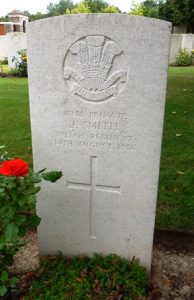
David Matthias Williams, Sergeant, 240101, Royal Welsh Fusiliers. David was the son of Evan and Catherine Williams, of Bryntirion, Rhyd, Llanfrothen, Penrhyndeudraeth. By 1911 he was lodging at Colwyn Bay, where he worked as a Bank Clerk for the London City & Midland Bank. David enlisted at Colwyn Bay into the 5th Battalion, Royal Welsh Fusiliers on 11 January 1911. The battalion was a Territorial unit, attached to North Wales Brigade, Welsh Division and over the next few years, David attended Annual Camp at Lamphey, Carnarvon and at Rhyl. Following the outbreak of war, he was he mobilised with the battalion, which joined North Wales Brigade at Conwy, and moved to Northampton at the end of August 1914. On 13 May 1915 the formation became 158 Brigade, 53rd (Welsh) Division, and on 19 July sailed from Devonport for Imbros, before landing at Suvla Bay on 9 August 1915. Following the evacuation from Gallipoli the Division moved to Egypt, but David soon took ill and was hospitalised before being sent home on 27 January 1916. Once he had recovered, he was posted back out to Egypt on 9 September 1916 and took part in the Divisions advance into Palestine the following year, fighting at the three Battles of Gaza and in the capture of Jerusalem and Jericho. David survived the war, and following the Armistice the Division moved to Alexandria, where the 5th and 6th Battalions of the RWF merged to become the 5/6th Battalion. He took ill soon afterwards and died of broncho-pneumonia on 20 January 1919, aged 26. David is buried in Alexandria (Hadra) War Memorial Cemetery, Egypt. He is also commemorated on the Colwyn Bay War Memorial. His brother, David Morris Williams, was killed at sea in 1917. (There are three men named D M Williams from Penrhyndeudraeth who fell during the Great War, but the name is only listed once on the memorial).
David Morris Williams, Seaman, 7539A, Royal Naval Reserve. David was born on 25 March 1885, the eldest son of Captain John Williams and Elizabeth Williams, of Stentir, Minffordd, Penrhyndeudraeth. Following in his father’s footsteps, he was a long serving Merchant Mariner, and following the outbreak of war joined the Royal Naval Reserve on 14 January 1915. He was posted aboard the requisitioned trawler HM Trawler Lord Roberts, which had been converted for anti-submarine duties. On 26 October 1916 Lord Roberts was on patrol off Suffolk when she struck a mine which had been laid by the German submarine UC-11, some eleven miles off the Shipwash Light Vessel, exploded and sank with the loss of nine men. David was 31 years old when he was killed that day, and is commemorated alongside his fellow crew on the Portsmouth Naval Memorial, Hampshire. (There are three men named D M Williams from Penrhyndeudraeth who fell during the Great War, but the name is only listed once on the memorial).
David Morris Williams, Seaman Cook, Mercantile Marine. David was the son of Evan and Catherine Williams, of Bryntirion, Rhyd, Llanfrothen, Penrhyndeudraeth. He worked as a tailor at Porthmadog prior to the war and married Jane Williams, of Station House, Porthmadog, in 1915. David volunteered to serve in the Mercantile Marine and was posted aboard the Sailing Vessel Ellen James, which was based at Porthmadog under Master Richard Cadwallader Jones, of Criccieth. On 3 April 1917 Ellen James was sailing west of Ushant, returening from Huelva to Penrhyn, carrying a cargo of copper pyrites, when she was stopped by the German submarine UC-71. The submarine then proceeded to fire her deck gun at the helpless schooner, sinking her with the loss of five of her crew of six, including two men from Penrhyndeudraeth, David and John Thomas Roberts. David was 32 years old when he was killed in the sinking of Ellen James, and is commemorated on the Tower Hill Memorial, London. David is also commemorated at Porthmadog. His brother, David Matthias Williams, died in Egypt in 1919. (There are three men named D M Williams from Penrhyndeudraeth who fell during the Great War, but the name is only listed once on the memorial).
Griffith Hughes Williams, Private, 11551, Leicestershire Regiment. Griffith was the son of Griffith and Elizabeth Williams, of Penrhyndeudraeth. He served with the Imperial Yeomanry during the Boer War and upon returning from South Africa lived in London, re-enlisting into the 3rd County of London Imperial Yeomanry (Sharpshooters), which was formed from Boer War veterans. He married Ethel Jane Doggett on 5 June 1906 and the couple lived at 31, Pellerin Road, Stoke Newington, London N. Griffith re-enlisted into the Leicestershire Regiment at Walthamstow on 13 August 1914 and was posted to their 3rd Battalion for recruits training. Within less than two months he suffered a breakdown and was discharged from the army after being diagnosed with dementia. Griffith was then sent to Brentwood Asylum, where he died of general paralysis on 22 February 1915, aged 36. Griffith is not commemorated by the Commonwealth War Graves Commission as his illness was not brought on by his brief wartime service.
John Lewis Williams, Sapper, 132080, Royal Engineers. John was the son of Margaret Williams, of Glanllyn, Penrhyndeudraeth. He had served with the 4th Battalion, Royal Welsh Fusiliers (Territorial Army) prior to the war, and on 28 September 1914 re-enlisted into the 6th Battalion, Royal Welsh Fusiliers. He was discharged as medically unfit on 4 September 1915, after being diagnosed as suffering from cirrhosis of the liver, and re-enlisted into the Royal Engineers on 24 September, being posted to France with No 3 Provisional Company, Royal Engineers. His poor health again resurfaced and he was discharged from the Royal Engineers on 5 July 1916, but undeterred, John enlisted once again, joining the Labour Corps. He was posted back out to France, where he continued to serve after the Armistice. John was accidentally killed whilst working on the old battlefields on 20 October 1919, aged 44. He is buried in Poelcapelle British Cemetery, Belgium. (The memorial shows a J Williams and a J E Williams, but not J L Williams).
John Lloyd Williams, Private, 132807, Royal Flying Corps. John was the son of John Lloyd Williams and Mary Catherine Williams, of Penbryn View, Penrhyndeudraeth. He enlisted into the Royal Flying Corps, and served with them throughout the war. Little else is known of him, but he died on 1 January 1923, aged 24. He is not commemorated by the Commonwealth War Graves Commission. (The memorial shows a J Williams and a J E Williams, but not J L Williams).
John Richard Williams, Private, M/337674, Royal Army Service Corps. John was born at Colwyn Bay. He married Mary Ann Davies, of Penrhyndeudraeth, prior to the war, and the couple had a daughter, Mary Elizabeth. John enlisted at Wrexham into the Army Service Corps, and was posted to Egypt with the 1009th Mechanical Transport Company, ASC. The unit was one of many formed by the ASC during the war, to cope with the massive task of supplying food, munitions and other goods to the men in the lines, often under very arduous conditions, and using a wide variety of motor vehicles, lorries, steam engines and so on. John was invalided to the 21st General Hospital, Alexandria in November 1917, and died there on 3 December 1917. He is buried in Alexandria (Hadra) War Memorial Cemetery, Egypt.
Lewis Edward Williams, Private, 291338, Royal Welsh Fusiliers. Lewis was the son of Thomas and Margaret Williams, of 8, High Street, Penrhyndeudraeth. He enlisted at Penrhyndeudraeth into the 3/7th Battalion, Royal Welsh Fusiliers on 11 October 1914 and was posted to Park Hall Camp, Oswestry for training. On 4 September 1916 he was posted to Egypt to join the 1/7th Battalion, Royal Welsh Fusiliers, which was on the Suez Canal defences attached to 158 Brigade, 53rd (Welsh) Division. The Division was attached to the EEF, and helped guard the Suez Canal before taking part in operations to drive the Turks out of the Sinai. On 26 March 1917 the Division took part in the First Battle of Gaza, an attempt to capture the strategic city of Gaza from the Turks, but the battle failed due to heavy fog and poor communication. A second attack on Gaza took place on 17 April, but also failed, and the EEF was re-organised before a third assault was launched on 31 October 1917. At last Gaza was captured, and the path lay open for the EEF to advance on Jerusalem. Lewis was wounded on 6 November during the advance to Jerusalem, and was evacuated to hospital in Alexandria where he died of his wounds on 22 November 1917, aged 27. He is buried in Alexandria (Hadra) War Memorial Cemetery, Egypt. His brother, Thomas John Williams, was killed on the same day that Lewis was wounded.
Thomas John Williams, Lance Corporal, 290431, Royal Welsh Fusiliers. Thomas was the son of Thomas and Margaret Williams, of 8, High Street, Penrhyndeudraeth. He enlisted at Penrhyndeudraeth into the 7th Battalion, Royal Welsh Fusiliers on 14 June 1911, and attended annual Territorial camp at Lamphey, Carmarthen, Rhyl and Aberystwyth over the coming years. The battalion was attached to North Wales Brigade, Welsh Division, and mobilised for war at Newtown in August 1914. It moved to Conway until the end of the month, before moving to Northampton. In December the Division moved to Cambridge and then in May 1915 to Bedford, where the Division was numbered and the formation became 158 Brigade, 53rd (Welsh) Division. On 19 July 1915 the entire Division sailed from Devonport for Imbros and on 9 August 1915 landed at Suvla Bay. Thomas was shot in the leg four days after the landing at Gallipoli, and was sent home for treatment, before returning to Egypt on 10 December 1916 to re-join his battalion, which was on the Suez Canal defences. On 26 March 1917 the Division took part in the First Battle of Gaza, an attempt to capture the strategic city of Gaza from the Turks, but the battle failed due to heavy fog and poor communication. A second attack on Gaza took place on 17 April, but also failed, and the EEF was re-organised before a third assault was launched on 31 October 1917. At last Gaza was captured, and the path lay open for the EEF to advance on Jerusalem. Thomas was killed in action on 6 November 1917 during the advance on Jerusalem. His brother, Lewis, was wounded the same day and died two weeks later. Thomas was 24 years old and is buried in Beersheba War Cemetery, Israel.
William Williams, Private, 203646, Royal Welsh Fusiliers. William was the son of William and Margaret Williams, of Erw Fawr, Llanfrothen, Penrhyndeudraeth. He enlisted at Dolgellau into the 4th Reserve Battalion, Royal Welsh Fusiliers on 21 January 1917, and on 20 July 1917 was posted to the Infantry Base Depot in France. On 5 August 1917 he was posted to the 17th Battalion, Royal Welsh Fusiliers. The battalion was attached to the 38th (Welsh) Division, which had taken part in the assault on Pilckem Ridge on 31 July 1917, suffering heavy casualties in its successful advance to the Steenbeek. William was among a number of reinforcements posted to the battalion to help rebuild its numbers. William joined up with the 17th RWF at Seaton Camp, near Sainte-Sixte. On 9 September the battalion marched to Proven, and the entire 38th Division entrained, beginning its move from Ypres to new positions at Sailly-Sur-La-Lys, where it remained over the winter. The Germans launched their Spring Offensive on the Somme on 21 March 1918, and the 38th Division was sent south, to relieve the battered 2nd and 47th Divisions, and took up positions facing Thiepval Ridge. On 21 August the Division launched an attack across the flooded Ancre Valley and by the afternoon had captured Thiepval Ridge, before beginning its famous advance across the old Somme battlefields towards the Hindenburg Line. On 29 September the Hindenburg Line was broken, and the Allies began advancing past it towards the German frontier. William was seriously wounded during the Battle of Cambrai, as the Division was pushing towards Le Cateau, and died of his wounds at No 3 Casualty Clearing Station on 8 October 1918. The 20-year-old is buried in Rocquigny-Equancourt Road British Cemetery, Manancourt, France. He is not commemorated on the Penrhyndeudraeth memorial.
William Morris Williams, Private, 267304, Royal Welsh Fusiliers. William was born on 27 October 1877, the son of Morris and Margaret Williams, of Rock Terrace, Penrhyndeudraeth. He worked as a miner prior to enlisting into the 3/7th Battalion, Royal Welsh Fusiliers on 30 December 1915, and was posted to Park Hall Camp, Oswestry. On 25 March 1915 he voluntarily transferred into the Royal Engineers, and was posted to the Special Service Brigade Depot at Porton Down, for training in gas warfare. A year later, on 28 April 1916, William deserted from the Royal Engineers. Whilst the authorities were trying to locate him, he re-enlisted into the Royal Welsh Fusiliers at Wrexham on 27 June 1916, giving his brothers address in Brymbo, and was posted to the 6th Battalion, Royal Welsh Fusiliers. He was posted out to Egypt, joining the 6th RWF on the Suez Canal Defences. The battalion was attached to 158 Brigade, 38th (Welsh) Division, which formed part of the EEF, and was preparing to launch the offensive into Palestine. On 26 March 1917 the Division took part in the First Battle of Gaza, an attempt to capture the strategic city of Gaza from the Turks, but the battle failed due to heavy fog and poor communication. A second attack on Gaza took place on 17 April, but also failed, and the EEF was re-organised before a third assault was launched on 31 October 1917. By now, William’s health had broken down, and he was diagnosed as suffering from tuberculosis on 17 December 1917. He was sent home and was discharged from the army as medically unfit on 7 January 1918. William died of tuberculosis on 23 December 1918, aged 40. He is buried in Bethesda Cemetery, Blaenau Ffestiniog.
William Richard Williams, Private, 203672, Royal Welsh Fusiliers. William was the son of John and Dorothy Williams, of Pen-y-Bwlch Cottage, Penrhyndeudraeth. He worked as a cowman prior to enlisting at Dolgellau into the 4th Reserve Battalion, Royal Welsh Fusiliers on 21 January 1917, and was posted to Wrexham for training. He landed in France on 2 August 1917 and was sent to No 5 Infantry Base Depot. On 17 August 1917 William was posted to the 16th Battalion, Royal Welsh Fusiliers, which was at Ypres attached to 113 Brigade, 38th (Welsh) Division. The Division had taken part in the assault on Pilckem Ridge on 31 July 1917, suffering heavy casualties in its successful advance to the Steenbeek. William was among a number of reinforcements posted to the battalion to help rebuild its numbers. William joined up with the 16th RWF at Persia Camp, near Sainte-Sixte. On 9 September the battalion marched to Proven, and the entire 38th Division entrained, beginning its move from Ypres to new positions at Sailly-Sur-La-Lys, where it remained over the winter. The Germans launched their Spring Offensive on the Somme on 21 March 1918, and the 38th Division was sent south, to relieve the battered 2nd and 47th Divisions, and took up positions facing Thiepval Ridge. In front of the Division was the German held Bouzincourt Ridge, which afforded views across the Ancre Valley to Thiepval, so the Division was ordered to drive the Germans back across the river. At dawn on 22 April 1918 the 16th RWF launched their attack, behind a creeping artillery barrage, but was hit by heavy machine-gun fire and the attack failed. The battalion had suffered the loss of 5 officers and 38 men killed; 8 died of wounds; two officers and 20 men missing and two officers and 159 men wounded. Among the missing was William, who was afterwards adjudged to have been killed in action during the attack. The 19-year-old has no known grave and is commemorated on the Pozieres Memorial, France.
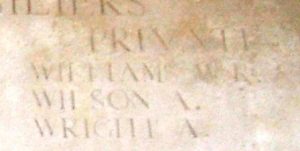
World War Two, 1939-1945
David Charles Askew, Driver, T/168451, Royal Army Service Corps. David was born in Fobbing, Essex on 13 May 1917, the son of Samuel Jesse Askew and Grace Harriet Askew (nee McLean). By 1939 the family had moved to Brongwynedd, Penrhydeudraeth. David worked as an explosives lorry driver prior to enlisting into the Royal Army Service Corps, and was posted out to the Far East with the 18th Infantry Division. David was captured by the Japanese following the surrender of Singapore on 15 February 1942, and in 1943 was sent to work on the Thai-Burma Railway. He died in captivity on 6 December 1943, aged 26, and is buried in Kanchanaburi War Cemetery, Thailand.
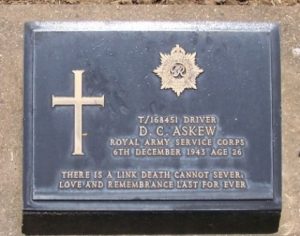
Evan David Evans, Marine, PLY/X. 104776, Royal Marines. Evan was the son of David Evans and Bridget Evans (nee Owens), of Penrhyndeudraeth. He enlisted into the Royal Marines following the outbreak of war, and after completing his training was attached to the Plymouth Division, RM. Evan died of cerebro-spinal meningitis at Haslar Royal Naval Hospital on 17 January 1942, aged 21. His remains were brought home for burial in Minffordd Cemetery.
Hugh Evans, Chief Officer, Merchant Navy. Hugh lived at Brewet Bridge, Penrhyndeudraeth, and was a long serving mariner. He served with the Merchant Navy as Chief Officer of the Liverpool registered tanker MV Cordelia. On 3 February 1943, Cordelia was a straggler from Convoy HX-224, and had departed from Curaçao via New York to the Clyde carrying a cargo of 12,000 tons of Admiralty fuel oil. The ship was spotted by the German submarine U-632 south of Iceland, which proceeded to fire a torpedo at Cordelia, which exploded and sank. Forty-six lives were lost in the sinking, with just one survivor. The survivor was picked up by the U-Boat and taken to Brest. Hugh was 48 years old when he was killed in the sinking that day, and is commemorated on the Tower Hill Memorial, London.
John Evans, Craftsman, 7617489, Royal Electrical and Mechanical Engineers. John was the son of Moses Evans and Ellen Alice Evans (nee Davies), of Noddfa, Penrhyndeudraeth. He enlisted into the Royal Electrical and Mechanical Engineers, and was posted to Palestine. Little is presently known of his war service, but he died in Palestine on 11 November 1944, aged 25, and is buried in Ramleh War Cemetery, Israel.
Thomas Walter Honeybun, Private, 14903238, Pioneer Corps. Thomas was the son of Charles Honeybun and Margaret Ellen Honeybun (nee Hughes), of 4, Nazareth Terrace, Penrhyndeudraeth. Little is presently known of his wartime service, but he had served with the Pioneer Corps. Thomas died on 14 October 1946, aged 19, and is buried in Minffordd Cemetery.
Edward John Jones, Able Seaman, C/JX 169489, Royal Navy. Edward was born on 23 January 1919, the son of Maggie J. Jones, of Minffordd. He enlisted into the Royal Navy, and after completing his training was posted aboard the heavy cruiser, HMS Cornwall. She had spent most of her pre-war service assigned to the China Station, but following the outbreak of war was assigned to search for German commerce raiders in the Indian Ocean. Cornwall transferred to the South Atlantic in late 1939, to take part in convoy escort duties, but after the start of the Pacific War in December 1941, was transferred to the Eastern Fleet. On 4 April 1942, Cornwall HMS Dorsetshire set out from harbour following reports of the sighting of a Japanese Fleet. On the following day, the two cruisers were sighted by a Japanese aircraft, some 200 miles south-west of Ceylon. On 5 April 1942, the two cruisers were attacked by a wave of Japanese dive-bombers, and were sunk with the loss of 424 lives. Over 1,100 survivors spent over a day in the sea before being rescued. Edward was 23-years-old when he was killed in the sinking of HMS Cornwall, and is commemorated on the Chatham Naval Memorial, Kent.
Griffith John Jones, Driver, 2011942, Royal Engineers. Griffith was born on 4 April 1915, the second son of Griffith Edward Jones and Margaret Jones (nee Williams), of Penrhyndeudraeth. His father was killed at Gallipoli in 1915, so Margaret raised her two sons alone. Griffith enlisted into the Royal Engineers following the outbreak of war, and after training was posted to the 9th Bomb Disposal Company, which operated in Coventry and Birmingham. He survived the infamous Coventry Blitz, but from 9 April 1941, Birmingham became targeted, and suffered several nights of bombing, which caused terrible carnage and destroyed the city centre. Griffith was killed in Birmingham on 13 April 1941, aged 26, probably whilst trying to defuse one of the German bombs which had been dropped over the preceding days. His remains were brought back home for burial in Minffordd Cemetery.
Stanley O. Jones, Leading Aircraftman, 1530976, Royal Air Force Volunteer Reserve. Stanley was the son of Owen Jones and Dorothy May Jones (nee Osborne), of 7, Bryn Islwyn, Penrhyndeudraeth. He enlisted into the Royal Air Force Volunteer Reserve and was posted to 2743 Squadron, RAF. The squadron had formed at Bircham Newton and became an Anti-Aircraft squadron on 1 May 1943, moving to Foulness Island, Southend 30 July 1944. Several more moves followed before the squadron embarked for India on 15 January 1945. Stanley died in India on 20 February 1945, aged 22, and is buried in Maynamati War Cemetery, in what is now Bangladesh.
Tecwyn Jones, Trooper, 7935910, Royal Tank Regiment. Tecwyn was the Grandson of Margaret Jones, of Llys Tecwyn, Penrhyndeudraeth. He was named after an uncle who was killed in WW1. Tecwyn was a munitions worker prior to enlisting into the Royal Tank Regiment, and after training was posted to the 51st (Leeds Rifles), Royal Tank Regiment. The regiment moved to Northumberland, for coastal defence duties, soon after the outbreak of war as part of the 25th Army Tank Brigade. By the end of 1942 the Brigade was trained and fully equipped with Churchill tanks and during January 1943 embarked with the rest of the 25th Tank Brigade for North Africa, to take part in the Tunisian Campaign. Tecwyn had only been in Egypt several weeks when he died on 27 January 1943, aged 22. He is buried in Heliopolis War Cemetery, Egypt.
William Emlyn Roberts, Corporal, 7022387, Royal Ulster Rifles. William was born on 9 January 1921, the son of William Morris Roberts and Annie Roberts (nee Williams), of Castle Cottage, Penrhyndeudraeth. He enlisted into the army and was posted to the 2nd Battalion, The London Irish Rifles. The Battalion sailed from Greenock to Algiers along with the rest of 38th (Irish) Brigade in November 1942 and saw its first action in northern Tunisia near Bou Arada in December 1942. The battalion took part in six-months of fighting west of Tunis before becoming the first troops into the city in May 1943. The battalion then took part in the Sicilian campaign during August 1943 before crossing to Taranto on the mainland of Italy at the end of September 1943 and then took part in the Italian campaign. William was killed during fighting around Lake Trasimene on 21 June 1944, aged 23. He is buried in Orvieto War Cemetery, Italy.
William John Thomas, Private, 965674, Pioneer Corps. William was born on 30 April 1918, the son of Joseph Owen and Margaret Ann Thomas, of Penrhyndeudraeth. He worked as a quarry labourer prior to enlisting into the army and was posted to the Pioneer Corps. Little else is known of his wartime service, but William died in Austria on 19 June 1945, aged 27, and is buried in Klagenfurt War Cemetery, Austria.
Thomas John Whitford, Sapper, 4207274, Royal Engineers. Thomas was the son of William Henry Whitford and Ivy Whitford (nee Clift), of Glyncorrwg, Glamorgan. He married Margaret Pritchard, of Brondanw Uchaf , Penrhyndeudraeth, in 1943. Thomas enlisted into the Royal Engineers, and was posted to Italy soon after marrying, joining the 10th Railway Construction Company, RE. The company was one of a number sent out to Italy following the Allied invasion, in order to repair the railways and rail infrastructure which had been destroyed by the Germans during their slow withdrawal north. Thomas died in Italy on 3 June 1945, aged 24, and is buried in Forli War Cemetery, Italy. He is not commemorated on the Penrhyndeudraeth memorial.
Dewi Wyn Williams, Leading Aircraftman, 1530117, Royal Air Force Volunteer Reserve. Dewi wasthe son of Robert Richard Williams and Elizabeth Williams (nee Jones), of Annfield, Penrhyndeudraeth. He enlisted into the Royal Air Force Volunteer Reserve, and was posted out to Canada for training under the Empire Air Training Scheme. Dewi took ill whilst undergoing his training and died in Christie Street Hospital, Toronto from sulfathiazole poisoning on 23 April 1944, aged 21. He is buried in Toronto (Prospect) Cemetery, Canada.
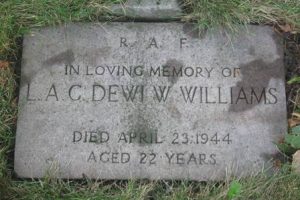
Evan Jones Williams, Private, 13017534, Pioneer Corps. Evan was born at Penrhyndeudraeth on 27 August 1901. He married Gwen Griffiths in 1934, and the couple lived in 8, Pool Street, Penrhyndeudraeth. Evan enlisted into the army and was posted to the Auxiliary Military, Pioneer Corps, which had been formed in September 1939 from reservists. Little else is known of Evan, but he died on 24 August 1940, aged 38, and is buried in Minffordd Cemetery.
Evelyn Eileen Williams, Leading Wren, 1160, Women’s Royal Naval Service. Evelyn was born in Penrhyndeudraeth on 3 July 1921, the daughter of Watkin Dresser Williams and Doris Evelyn Williams (nee Morgan). Her father had served in WW1, before joining the Police and had been a Police Sergeant at Towyn prior to the war. Evelyn enlisted into the Women’s Royal Naval Service, and was attached to HMS Monck, the Combined Forces training establishment at Largs. She was attached to the landing carrier training centre at Port Glasgow. Evelyn took ill whilst based there and died of Bronchiectasis at Hairmyres Hospital, near Glasgow on 21 January 1945, aged 23. Her remains were brought home for burial in St. Twrog Churchyard, Maentwrog.
Griffith Emlyn Williams, Sergeant, 1048364, Royal Air Force Volunteer Reserve. Griffith was the son of John Williams and Mary Ellen Williams (nee Owen), of 33, Glyn Llifon Street, Blaenau Ffestiniog. He lived in Penrhyndeudraeth prior to enlisting into the Royal Air Force Volunteer Reserve, and trained as a Wireless Operator/ Air Gunner before being posted to No 3 Overseas Air Despatch Unit, at RAF Talbenny, in Pembrokeshire. On 3 October 1943, Griffith was flying aboard Vickers Wellington X, Serial HZ957, when it came down into the sea near the Isles of Scilly, killing all six men aboard. 23-year-old Griffith has no known grave and is commemorated on the Runnymede Memorial, Surrey.